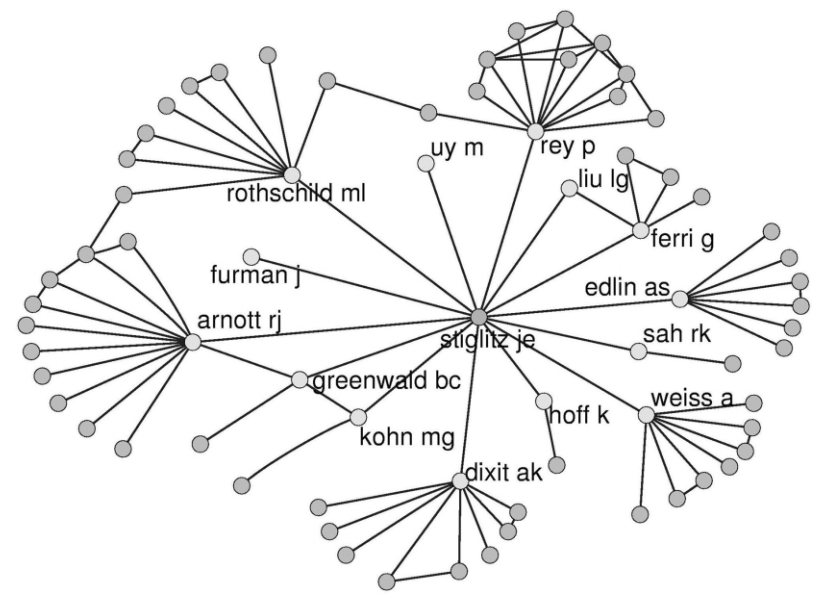This is a small world, as we know it. Most people are connected through the so-called “six degrees of separation”. But what does it mean for our professional life? Researchers have found very short paths in collaboration networks within professional communities. There is a “connection” if two authors have collaborated/coauthored before. A “path” means the degrees of separation between any two authors. My coauthor and I have a “distance” of one. The distance between me and my coauthor’s coauthor is two, and so on.
So how short are the paths? In the domain of mathematics, for example, the genius-mathematician Paul Erdös, who has written 1,500 papers over his career, is often considered the central figure of the collaborative structure of the field. The figure below (yes, it is messy) depicts a collaborative graph for Paul Erdös, with him in the center. A mathematician’s Erdös number is the distance from him/her to Erdös. It is found out that most mathematicians have a Erdös number of at most 4 or 5. And it is not just mathematics — it is found that the Erdös number of other science field (e.g. physics) is comparable or even smaller.
Figure 1: Paul Erdös’s collaboration graph
Sources: Easley and Kleinberg (2010)
As an economist by training, I’m more interested to learn about the Erdös number for the economics profession. According to Goyal et al., this average distance was 12.86 in the 1970s, 11.07 in the 1980s, and 9.47 in the 1990s. This is a relatively high number comparing to the science field possibly because economics is “separated” into many subfields — a microeconomist is unlikely to collaborate with a macroeconomist, for example. But it is also notable that the distance has decreased by 25 percent in the two decades (I guess the distance is even smaller in the 2000s), which means the economists are more connected, or put it another way, there are more coauthorships happening.
A few star economists have a lot of connections. On the surface, it should not be that surprising because these economists should have written a lot of papers, which is how they become famous in the first place. But what is interesting actually is that the star economists’ coauthors have few coauthors and do not coauthor among each other. See, for example, the coauthorship graph for Joseph Stiglitz in the 1990s. It can be clearly seen that Stiglitz is at the center of a network of people. If we take Stiglitz out, the giant component would break down into many small pieces. This is quite different from the usual social network that we see in life, where you friends’ friends tend to be friends with each other, or put it in another way, they would “cluster” together.
In the words of Goyal:
We find that the removal of 5 percent of the authors at random leads to a marginal change in the giant component and clustering, whereas the deletion of the 5 percent most linked nodes leads to a complete breakdown of the giant component and a sharp increase in the clustering coefficient… We therefore conclude that the world of economists has been and still is spanned by a collection of interlinked stars and that this is critical for understanding the short average distances.
Figure 2: Local network of collaboration of Joseph E. Stiglitz in the 1990s
Sources: Goyal (2006)
I’m thinking that the aspiring economists would naturally want to coauthor with star economists, even if, in practice, the aspiring economists may have to do most of the work. Put it in another way, once you get famous, there will be other people who would be willing to share their coauthorship with you, and you can easily produce more papers. This is a very much “the rich get richer” situation (which happens a lot in other kinds of networks too). I have not looked into the situations in other social science subjects, but I would image that the network structures are similar.
This may explain the hierarchy of the economics profession. I’m fortunate to be surrounded by many of these star economists here at Harvard. Well, I think I should start working with them too.


Post a Comment